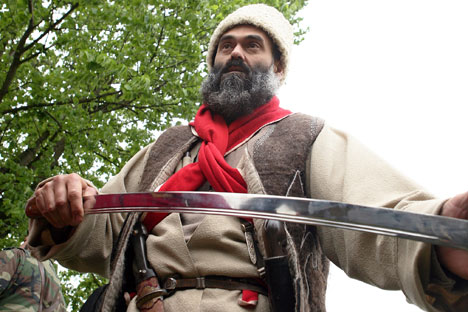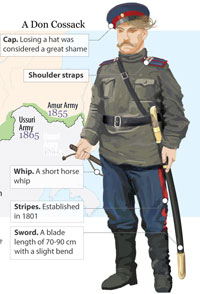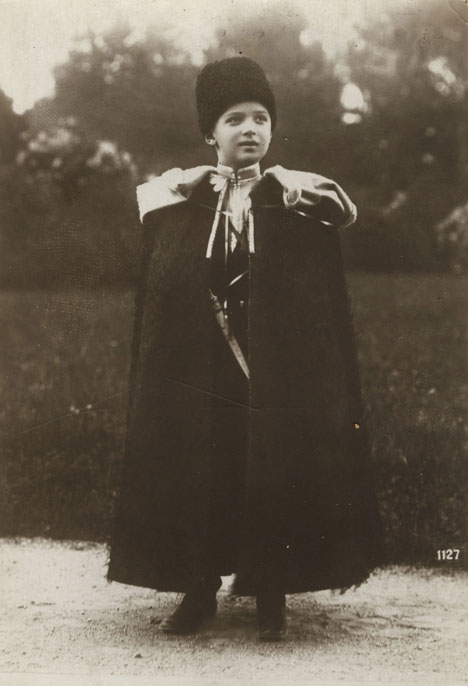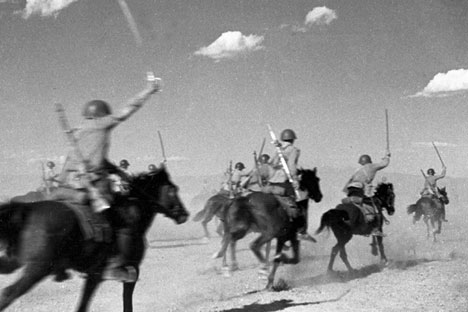The shashka – the highland blade that came down to the masses


A cossack with shashka, Rostov region. Source: Viktor Pogontsev / TASS / Interpress
First forged by Caucasian highlanders, the shashka sword was compact, easy to use, highly lethal, and a weapon for life.
Midway between a full saber and a straight sword, the shashka was actually inspired by traditional Caucasian daggers, drawing its name from the Circassian for “big knife.”
Often fashioned with an ornate blade and hilt, it was the traditional side-arm of the Circassian hillfolk for centuries before its rise to prominence in the 1900s in the Russian army.
 |
| Click to enalrge the infographics 'The history of the Cossacks' |
Also resembling a thin, tapered machete, the gently curving blade of the shashka can be up to a meter (3.3 feet) long and a kilogram (2.2 lbs) in weight. The proportions and design were ideal for mountain fighting, clashes on narrow winding tracks and in forest - or in a melee of infantry or cavalry.
While the weapon was widely accessible, mastering it demanded specific skills as the absence of a hand guard made it hard to parry blows. But its slender lines also meant it could be quickly unsheathed to strike hard and fast without a swing, and returned just as quickly to the on-guard position to strike again.
Often a single lunge with the weapon sufficed, much like the Japanese warrior’s samurai sword. But unlike the samurai and sabre, the shashka was easy to make, an essential requirement for these poor Caucasus regions.
Russian Cossacks who settled in the foothills of the Caucasus and served as border guards quickly saw the advantages of the highland weapon.
The Circassians were their worst enemies but the Cossacks still adopted many basic elements of their military dress and weapons, like the massive papakha fur hat.

Chromolithographed Victorian greeting card titled Russia Cossack. Source: The Art Archive / Amoret Tanner Collection
They also appropriated their favourite bladed weapon and the Circassian art of twirling it for visual effect, as well as their dzhigitovka horseback trick riding, which the Cossacks essentially made a sport of.
The Russians also took the adopted weaponry a step further. In 1838, an improved version called the Baklanov shashka entered service with Cossack units. Named after the legendary Cossack general and bane of the Circassians and Chechens, Yakov Baklanov, the weapon was a fusion of the shashka and the sabre. Having a curved blade and a displaced center of gravity, the weapon could decapitate an enemy in one solid blow.

Czarevich Alexis Nicholayevich Romanov, 1904-1918, in a cossack hat and cape; son of Czar Nicholas II, Emperor of Russia, shot by Bolsheviks after the revolution of 1917. Source: The Art Archive / Culver Pictures
Through the Cossacks the shashka quickly became popular throughout the Russian army. By the mid-19th century, many units were already carrying it, and by the second half of the century it had supplanted the saber as the main cavalry armament.
Hussar sabers and cuirassier and officers’ swords were gone, their large swinging arc rendering them obsolete in the age of firearms. Meanwhile, the compact shashka was often better suited to close-quarter fighting than a revolver.
By the start of World War I, the weapon had become a distinctive symbol of the Russian army, just as it had found fame and glory among the Cossack border guards.
After the 1917 Revolution the shashka became the primary edged weapon of the Red Army, and remained in use in Soviet cavalry units during the Second World War.

Cossacks attacking the enemy during the Second World War, on Jan. 6, 1943. Source: RIA Novosti
Until 1949 the shashkawas the standard dress weapon of Soviet generals, and was issued to guard of honor soldiers from 1968.
Although serial production of the ancient weapon was discontinued in the Soviet Union in the 1950s due to the disbandment of the last cavalry units, it was to resume once more in Russia in 1998 amid a resurgence of Cossack tradition.
Read more: Like a whirlwind: The ‘lava flows’ of Russia’s Cossack cavalry>>>
All rights reserved by Rossiyskaya Gazeta.
Subscribe
to our newsletter!
Get the week's best stories straight to your inbox